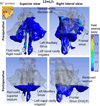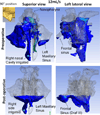Sinus irrigations before and after surgery-Visualization through computational fluid dynamics simulations
- PMID: 26467934
- PMCID: PMC5084453
- DOI: 10.1002/lary.25666
Sinus irrigations before and after surgery-Visualization through computational fluid dynamics simulations
Abstract
Objectives/hypothesis: Topical sinus irrigations play a critical role in the management of sinonasal disease, and the improvement in irrigant penetration into the sinuses postoperatively greatly contributes to the success of endoscopic sinus surgery. Prior investigations on postoperative sinus irrigations have been mostly limited to cadaver studies, which are labor intensive and do not capture the full dynamics of the flows. A pilot study was conducted to investigate the impact of surgery on sinus irrigation through computational fluid dynamics (CFD) simulations.
Study design: Retrospective computational study.
Methods: Pre- and postoperative computed tomography (CT) scans were obtained on a patient who underwent standard endoscopic surgeries for all sinuses, including a Draf III frontal sinusotomy. CT-based pre- and postoperative CFD models then simulated irrigations of 120 mL saline per nostril at 12 mL/s (typical of Sinugator) and 60 mL/s (SinusRinse Bottle), in two head positions: face parallel and at a 45° angle to the ground.
Results: Overall, surgery most significantly improved frontal sinus irrigation, but surprisingly resulted in less maxillary and ethmoid sinuses penetration. This may due to the partial removal of the septum during the Draf III, causing most fluid to exit prematurely across the resected septum. Higher flow rate slightly improved ethmoid sinus irrigation, but resulted in less preoperative contralateral maxillary sinus penetration.
Conclusions: CFD modeling of sinonasal irrigations is a novel technique for evaluating irrigant penetration of individual sinus cavities. It may prove useful in determining the optimal degree of surgery or the ideal irrigation strategy to allow for maximal and targeted sinus irrigant penetration.
Level of evidence: NA Laryngoscope, 126:E90-E96, 2016.
Keywords: Nasal irrigation; computational fluid dynamics; frontal; head position; maxillary; modeling; sinus surgery; sinusitis; sphenoid.
© 2015 The American Laryngological, Rhinological and Otological Society, Inc.
Conflict of interest statement
No conflict of interest and no financial disclosure.
Figures






References
-
- Wormald PJ, Cain T, Oates L, Hawke L, Wong I. A comparative study of three methods of nasal irrigation. Laryngoscope. 2004;114:2224–2227. - PubMed
-
- Harvey RJ, Goddard JC, Wise SK, Schlosser RJ. Effects of endoscopic sinus surgery and delivery device on cadaver sinus irrigation. Otolaryngol Head Neck Surg. 2008;139:137–142. - PubMed
-
- Thomas WW, III, Harvey RJ, Rudmik L, Hwang PH, Schlosser RJ. Distribution of topical agents to the paranasal sinuses: an evidence-based review with recommendations. Int Forum Allergy Rhinol. 2013;3:691–703. - PubMed
-
- Harvey R, Hannan SA, Badia L, Scadding G. Nasal saline irrigations for the symptoms of chronic rhinosinusitis. Cochrane Database Syst Rev. 2007 CD006394. - PubMed
Publication types
MeSH terms
Grants and funding
LinkOut - more resources
Full Text Sources
Other Literature Sources
Medical
Research Materials
Miscellaneous

